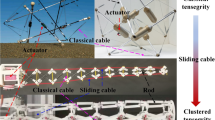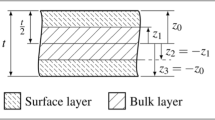Abstract
The use of a multibody methodology to describe the large motion of complex systems that experience structural deformations enables to represent the complete system motion, the relative kinematics between the components involved, the deformation of the structural members and the inertia coupling between the large rigid body motion and the system elastodynamics. In this work, the flexible multibody dynamics formulations of complex models are extended to include elastic components made of composite materials, which may be laminated and anisotropic. The deformation of any structural member must be elastic and linear, when described in a coordinate frame fixed to one or more material points of its domain, regardless of the complexity of its geometry. To achieve the proposed flexible multibody formulation, a finite element model for each flexible body is used. For the beam composite material elements, the sections properties are found using an asymptotic procedure that involves a two-dimensional finite element analysis of their cross-section. The equations of motion of the flexible multibody system are solved using an augmented Lagrangian formulation and the accelerations and velocities are integrated in time using a multi-step multi-order integration algorithm based on the Gear method.
Similar content being viewed by others
References
Shabana, A., ‘Dynamic analysis of large-scale inertia variant flexible systems’, Ph.D. Thesis, University of Iowa, Iowa City, Iowa, 1982.
Ambrósio, J. and J. Gonçalves ‘Complex flexible multibody systems with application to vehicle dynamics’, Multibody System Dynamics 6(2), 2001, 163–182.
Nikravesh, P., Computer-Aided Analysis of Mechanical Systems, Prentice Hall, Englewood-Cliffs, New Jersey, 1988.
Haug, E., Computer Aided Kinematics and Dynamics of Mechanical Systems, Allyn and Bacon, Boston, Massachussetts, 1989.
de Jalón, J. and E. Bayo Kinematic and Dynamic Simulation of Multibody Systems : The Real-Time Challenge, Springer-Verlag, New York, 1994.
Gonçalves, J. and Ambrósio, J., ‘Advanced modeling of flexible multibody dynamics using virtual bodies’, Computer Assisted Mechanics and Engineering Sciences 93, 2002, 373–390.
Bauchau, O. and D. Hodges ‘Analysis of nonlinear multibody systems with elastic couplings’, Multibody System Dynamics 3, 1999, 163–188.
Cesnik, C. and Hodges, D., ‘VABS: A new concept for composite rotor blade cross-sectional modeling’, Journal of the American Helicopter Society 42 1, 1997, 27–38.
Yoo, W.S. and Haug, E., ‘Dynamics of flexible mechanical systems using vibration and static correction modes’, Journal of Mechanisms, Transmissions and Automation in Design 108, 1986, 315–322.
Pereira, M. and Proença, P., ‘Dynamic analysis of spatial flexible multibody systems using joint coordinates’, International Journal for Numerical Methods in Engineering 32, 1991, 1799–1812.
Cavin, R. and Dusto, A., ‘Hamilton’s principle: Finite element method and flexible body dynamics’, AIAA Journal 15(12), 1977, 1684–1690.
Hodges, D., ‘A review of composite rotor blade modeling’, AIAA Journal 28(3), 1990, 561–565.
Reddy, J., Mechanics of Laminated Composite Plates: Theory and Analysis, CRC Press, Boca Raton, 1997.
Batoz, J. and Lardeur, P., ‘Adiscrete shear triangular nine d.o.f. element for the analysis of thick to very thin plates’, International Journal for Numerical Methods in Engineering 28, 1989, 533–560.
Lardeur, P., Development e evaluation de Deux elements finits de plaque e coques composites avec influence du cisalhement transversal Ph.D. Thesis, Université de Technologie de Compiègne, France, 1990.
Ochoa, O. and Reddy, J., Finite Element Analysis of Composite Laminates, Kluwer AcademicPublishers, Dordrecht, The Netherlands, 1992.
Oñate, E., Cálculo de Estruturas por el Método de Elementos Finitos, Segunda Edicion, Centro International de Métodos Numéricos en Ingenierìa, Barcelona, Spain, 1995.
Cook, R., Concepts and Applications of Finite Element Analysis, 2nd edn. Wiley and Sons, New York, 1987.
Yu, W. and Hodges, D., ‘On Timoshenko-like modeling of initially curved and twisted composite beams’, International Journal of Solids and Structures 39, 2002, 5101–5121.
Popescu, B. and Hodges, D. ‘On asymptotically correct Timoshenko-like anisotropic beam theory’, International Journal of Solids and Structures 37, 2000, 535–558.
Author information
Authors and Affiliations
Corresponding author
Rights and permissions
About this article
Cite this article
Neto, M.A., Ambr’osio, J.A.C. & Leal, R.P. Flexible Multibody Systems Models Using Composite Materials Components. Multibody Syst Dyn 12, 385–405 (2004). https://doi.org/10.1007/s11044-004-0911-2
Received:
Accepted:
Issue Date:
DOI: https://doi.org/10.1007/s11044-004-0911-2




